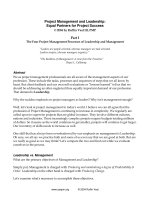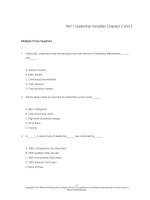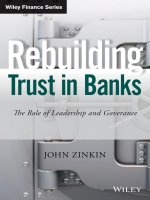Lecture Art of Leadership and Motivation - Lecture 8
Bạn đang xem bản rút gọn của tài liệu. Xem và tải ngay bản đầy đủ của tài liệu tại đây (472.7 KB, 36 trang )
Art of Leadership & Motivation
HRM – 760
Lecture - 8
FACILITATOR
Prof. Dr. Mohammad Majid Mahmood
Role of Leaders in
Downsizing:
Who Goes and Who Stays?
2
Faulty Assumptions
• Leaders will handle the downsizing just
fine because “they are leaders”
• Once we get past the downsizing, things
will return to normal
• We only need to worry about what is
happening inside the organization walls
3
The Tough Part of Downsizing:
How to say what you don’t want to say to
people who don’t want to hear it
4
Downsizing
What is Downsizing?
• Downsizing - process of reducing the number of
employees within an organization by eliminating jobs.
5
Downsizing
What is Downsizing?
• A downsizing strategy improve its financial
performance (Robbins & Pearce, 1992).
• A reduction of the workforce is one of only
several possible ways of improving
profitability or reducing costs.
6
Downsizing
Why do Firms Downsize?
• Reduce costs
• Reduce layers of management to increase
decision making speed and get closer to
the customer
• Sharpen focus on core competencies of
the firm, and outsource nonessential
activities
• Generate positive reactions from
shareholders
7
Downsizing
• Downsizing doesn’t guarantee improvements or cost
savings.
• It can have a devastating impact on employee morale
8
Downsizing Issues 2011 (EASNA Survey)
Financial
Stress
Legal
Violence
9
There is no perfect way to handle
downsizing that “feels right” or
“goes well” for everyone involved.
10
What happens to the
organization?
• Employees can turn into headcounts where there
is a decreased emphasis on understanding the
personal impact of downsizings and change
• Stress typically increases in response to
restructuring or increased workload
• The work environment is marked by fear of job
loss and paranoia (both real and imagined)
• The focus on employee engagement can change
to “just be glad you have a job”
• Resources shift away from “softer” people issues
like diversity, learning, safety and instead focus on
economic or business outcomes
11
The impact on surviving
employees
• Threat of job loss can increase the risk of
workplace accidents as surviving
employees show less concern for safety in
order to meet production standards
(2010 Journal of Occupational Health)
• Increased physical complaints, stress,
abuse, and domestic/social problems
• Crime, workplace theft, violence, and
suicide rates tend to increase
12
Downsizing Effects: Overall
• Mixed effects on firm performance: some
short-term costs savings, but long-term
profitability & assessment not strongly
affected.
• Firm’s reputation as a good employer
suffers. Example: Apple Computer’s
reputation as good employer declined after
several layoffs in 1990s.
• Downsizing forces re-thinking of
Employment Strategy. Lifelong
employment policies not credible after a
13
Downsizing Effects: Employee
Morale
• Employee motivation disrupted:
increase in political behaviors, anger, fear
- which is likely to negatively impact quality
of work
• Violation of psychological contract,
leads to distrust, and lowered work
commitment
• “Survivors” experience more stress due
to longer work hours with re-designed
jobs, and increased uncertainty regarding
14
Downsizing Effects: Workforce
Quality
• Many senior employees leave due to
application of early retirement incentives:
result is loss of institutional memory.
• The use of voluntary workforce reductions
(buyouts) results in the most marketable
employees leaving.
• Early retirements & voluntary reductions
often result in too many people quitting,
and some are hired back as consultants at
higher cost to firm.
15
Alternatives to Downsizing
(Gomez-Mejia, Balkin & Cardy, 2011)
Employment
Policies
Changes in
Job Design
Pay/Benefits
Policies
Training
Hiring freeze
Transfers
Pay freeze
Voluntary time
off
Reduced work
hours
Relocations
Cut over time pay Development
Job sharing
Use vacations &
leave days
Demotions
Pay cuts
Profit
sharing/variable
pay
Training
Retraining
16
Leadership Challenges in
Downsizing
• What are fair and effective HR policies for
separations, and downsizing?
• How can legal issues be minimized in
separations?
17
Prepare for Downsizing
• Communication is key
• Give as much warning as possible for
downsizings
• Announcement of downsizing(s) must be
managed
– Group meeting-individual meetings
– Individual meetings-group meeting
• Give facts • Determine where to hold the meeting
18
Prepare for Downsizing
Meetings
• Know organization policies and benefits
• Determine if security should be present
• Determine who will give notice and when
– Consider notice given by higher level
manager
– Followed by meeting with immediate manager
• Determine when notice is to be given
– Late in the day so employee(s) can leave
– Early in the morning before employees arrive
19
In the Process of Separation
• Use a private office
• Sit down one-on-one with the individual
• Be sure the employee hears about his or her
termination from a manager, not a colleague.
• Be clear
• Don’t leave room for confusion.
• Put everything in writing
• Provide written explanation of separation benefits.
• Allow no time for debate
• Tell the individual in the first sentence he or she is
terminated or laid off.
• Complete a firing session within 15 minutes.
20
In the Process of Separation
• Maintain the integrity of all
• Don’t make personal comments; keep the
conversation professional.
• Don’t rush the employee off-site unless security is
really an issue.
• Express appreciation for what the employee has
contributed, if appropriate.
• Don’t fire or lay people off on significant dates, like
the twenty-fifth anniversary of their employment or
the day their mother/father died.
• Don’t fire employees when they are on vacation or
have just returned.
21
What to say in Downsizing
•
•
•
•
Get to the point quickly
Avoid words like “fire” and “terminate”
Do not argue
Be prepared to listen sensitively but limit
discussion-
22
What to say in Downsizing
• Be honest:
– Tell the employee why he or she is being laid off.
– You may cushion the poor performance
assessment in a variety of ways, but the truth
must be told.
– For any downsizings due to poor performance, a
recent record of poor performance reviews will
support your decision and justify it to the
employee. It may also be used as evidence if a
wrongful dismissal suit is filed against the
employer.
23
What to say in Downsizing
• Be compassionate:
– Being laid off can be painful. Show the
terminated employee some sympathy and
understanding.
– If your company has the capability, provide
outplacement services or job counseling to
help cushion the blow.
– Keep the employee's ego in mind - you can
provide it by praising previous
accomplishments.
24
Completing the Downsizing
Meeting
• Listen and acknowledge concerns
• Remember this is not personal
• Stop giving unnecessary information- the
employee is not hearing you
• Have tissues available
• Offer to end the meeting or give the
employee a moment to leave
25









